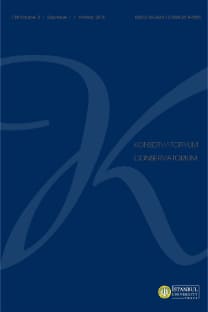Zri-Rab: Sri Lanka’nın Eski Fresklerinden Yeni Bir Yaylı Çalgı
Long-necked lute, Sgra-snyan, Thivanka Pilimage, Tar, Zri-rab
The Zri-Rab: A New String Instrument from the Ancient Frescos of Sri Lanka
Long-necked lute, Thivanka Pilimage, Sgra-snyan, Tar, Zri-rab,
___
- Augustyn, A. (2020). Art. In Encyclopedia Britannica. Retrieved from: https://www.britannica.com/art/visual-artsAzerbaijani musical instrument tar [Image]. (2013). Retrieved from: https://commons.wikimedia.org/wiki/File:A-zerbaijani_musical_instrument_tar_in_Heydar_Aliyev_Center.jpg google scholar
- Bell, H. C. P. (1914). Annual report 1909 archaeological survey of Ceylon. H. G. Cottle Government Printer. google scholar
- Bell, H. C. P. (1918). The “Demala-Mahá-Seya” frescoes. The Journal of the Ceylon Branch of the Royal Asiatic Society of Great Britain & Ireland, 26(71), 106–108. google scholar
- Busuttil, C. (2013). Experimental archaeology. Malta Archaeological Review,2008–2009 (9), 60-66. google scholar
- Charest, J. P. (2019). The long-necked lute’s eternal return: Mythology, morphology, iconography of the Tanbūr Lute family from Ancient Mesopotamia to Ottoman Albania. Doctoral dissertation, Cardiff University, Wales. Retrie-ved from: http://orca.cardiff.ac.uk/id/eprint/126268 google scholar
- Collinge, I. (1991). The “sweet sound” of the Tibetan lute: An examination of the principal cultural and musical associations of the sgra-snyan (Reformed 2002). Master’s thesis, University of London, SOAS. Retrieved from: https://www.researchgate.net/publication/361446114_Collinge_1991_Sweet_Sound_of_the_Tibetan_Lute google scholar
- Collinge, I. (1993). The dra-nyen (the Himalayan lute): An emblem of Tibetan culture. Chime: Journal of the Euro-pean Foundation for Chinese Music Research, 6, 22–33. google scholar
- Cowell, S. R., Handon, J. H., & Berkeley Music Library University of California. (1938). Tar, side view, plan, and elevation, mechanical drawing (Library of Congress Control Number 2017701323). Retrieved from: https://www.loc.gov/item/2017701323/ google scholar
- Dasanayaka, R. (2018). Ada Sanda saha Tharadiya. Godage Brothers. google scholar
- Dehideniya, I. (2022). Evolution of the Kandyan vina of Sri Lanka with special reference to the contemporary usa-ge. Vidyodaya Journal of Humanities and Social Sciences, 7(1). google scholar Dramyen [Image]. (n.d.). Retrieved from https://collections.ed.ac.uk/stcecilias/record/96035 google scholar
- During, J. (2013). Notes sur le tar azerbaïdjanais. Persian in Mahoor Music Quarterly, 15(58), 1–15. Retrieved from: https://www.academia.edu/5877206/on_the_Persian_and_Azerbaijani_ta google scholar During, J., Mirabdolbaghi. Z., & Safvat, D. (1991). The art of Persian music. Mage Pub. google scholar
- Godakumbura, C. (1969). Thivanka Pilimagei bithusithuvam. Archaeological Department.i.pinimg [Image]. (n.d.). Retrieved from: https://i.pinimg.com/originals/ae/46/80/ae4680694b03b5a2cc7c53c3f-2b8860a.jpg google scholar
- Joseph, G. A. (1918). The Gal-Yiharaya and Demala-Maha-Seya paintings at Polonnaruwa. The Journal of the Ceylon Branch of the Royal Asiatic Society of Great Britain & Ireland, 26(71), 101–106. google scholar
- Koumartzis, N., Tzetzis, D., Kyratsis, P., & Kotsakis, R. G. (2015). A new music instrument from ancient times: Modern reconstruction of the Greek lyre of Hermes using 3D laser scanning, advanced computer aided design and audio analysis. Journal of New Music Research, 44(4), 324–346 google scholar
- Kuckertz, J. (1970). Origin and development of the rabab. Sangeet Natak Akademi, 15, 16–30. Retrieved from: htt-ps://www.indianculture.gov.in/origin-and-development-rabab google scholar
- Maḫzan al-asrār. Niżāmī [Image]. (n.d.). Retrieved from: https://gallica.bnf.fr/ark:/12148/btv1b8432899d/f6.item.r=1029%20Paris%20Suppl%C3%A9me%20nt%20Persan.zoom?lang=EN google scholar
- Persian Tar String Musical Instrument [Image]. (n.d.). Retrieved from: https://www.ebay.com/p/18030225845 google scholar
- Psaroudakēs, S. (2020). How the present can inform the past, part I ancient and modern analogues as supplementary evidence in reconstructing an ancient instrument: Case in point: The Protocycladic II harp. Greek and Roman Musical Studies, 8(2), 217–229. google scholar
- Raymaekers, W. (1997), Report on the reconstruction of a 17th-century Dutch archaic type of violin. Retrieved from: https://www.academia.edu/42247405/Report_on_the_Reconstruction_of_a_17th_Century_Dutch_Archaic_Type_of_Violin google scholar
- Roberts, H. (1981). Reconstructing the Greek tortoise‐shell lyre. World Archaeology, 12(3), 303–312. google scholar
- Ruccius, A. (2014). The history of musical iconography and the influence of art history: Pictures as sources and in-terpreters of musical history. In R. Bod, J. Maat, & T. Weststeijn (Eds.), The making of the humanities: Volume III: The modern humanities (pp. 403–412). Amsterdam University Press. google scholar
- Sadie, S., & Tyrrell, J. (Eds.). (2001). The New Grove dictionary of music and musicians (Vol. 20; 2nd ed.). Oxford University Press. google scholar
- Somathilake, M. (2000). A historical study of Buddhist mural paintings of peninsular India and Sri Lanka during the ancient period (from second century BC to twelfth century AD). Doctoral dissertation, Jawaharlal Nehru Uni-versity, New Delhi. Retrieved from: http://hdl.handle.net/10603/16705 google scholar
- Suits, R. (n.d.). Reconstructing and making replicas of musical instruments from the conservator’s/ instrument ma-ker’s viewpoint. Retrieved from: http://rolandinstrument.com/pdf/poster_suits.pdf google scholar
- Taylor, L. A. (2021). Early medieval bone pipes: Understanding the sounds of these instruments through reconstruction. EXARC Journal, 2021(4). Retrieved from: https://exarc.net/ark:/88735/10600 google scholar
- The Metropolitan Museum of Art. (n.d.a). Tar. New York: Accession Number- 89.4.1858. Retrieved from: https://www.metmuseum.org/art/collection/search/502457 google scholar
- The Metropolitan Museum of Art. (n.d.b). Sgra-Snyan. New York: Accession Number- 1989.55. Retrieved from: https://www.metmuseum.org/art/collection/search/503939 google scholar
- Tivanka Image House - Ancient city of Polonnaruwa [Image] (n.d.). Retrieved from: https://www.lankatraveldirec-tory.com/places/north-central-province/polonnaruwadistrict/religious/thivanka-image-house/ google scholar
- Von Hornbostel, E. M., & Sachs, C. (1961). Classification of musical instruments (A. Baines & K. P. Wachsmann, Trans.). The Galpin Society Journal, 14, 3–29 google scholar
- Wijerathna, G. R. N. (2014). Polonnaru yugaye purawidyathmaka sthana ashritha baudda agamika godanegili awa-kashayanhi pihiti murthi ha katayam magin niruupitha nuthya, sangeetha ha natya kala lakshana, kulathilaka kumarasinghe-wicharalokanaya, Retrieved from: http://repository.kln.ac.lk/handle/123456789/12680 google scholar
- Young man with rubab [Image]. (n.d.). Retrieved from: https://commons.wikimedia.org/wiki/File:Young_man_with_rubab,_16th_century,_Safavid_Empire.jpg google scholar
- ISSN: 2146-264X
- Yayın Aralığı: 2
- Başlangıç: 2011
- Yayıncı: İstanbul Üniversitesi Devlet Konservatuvarı
Zri-Rab: Sri Lanka’nın Eski Fresklerinden Yeni Bir Yaylı Çalgı
Yakup Kadri Karaosmanoğlu’nun Sağanak Adlı Oyununda Evin Poetikası
Gerçeklik Meselesi: Ibsen'ın Yaban Ördeği ile Çehov’un Martı'sının Gerçek Hayata Uygunluğu
Hamlet Makinesi'nin Postdramatik Yapısı
Ara Dinkjian’ın Müzikal Kimliğinin Türk Popüler Müziği Besteciliği Üzerindeki Yansımaları
Üretirken Direnmek: Türkiye Punk Sahnesinde Kendin Yap
